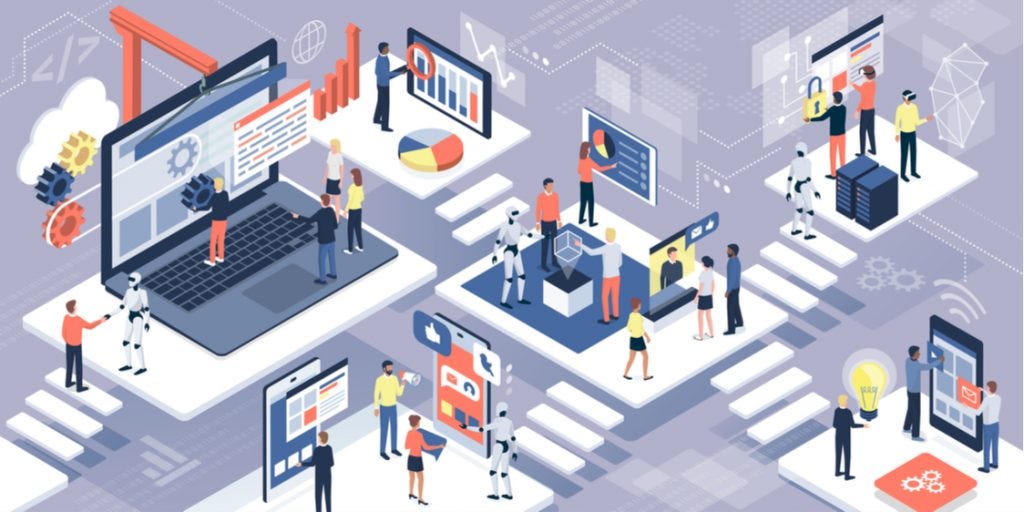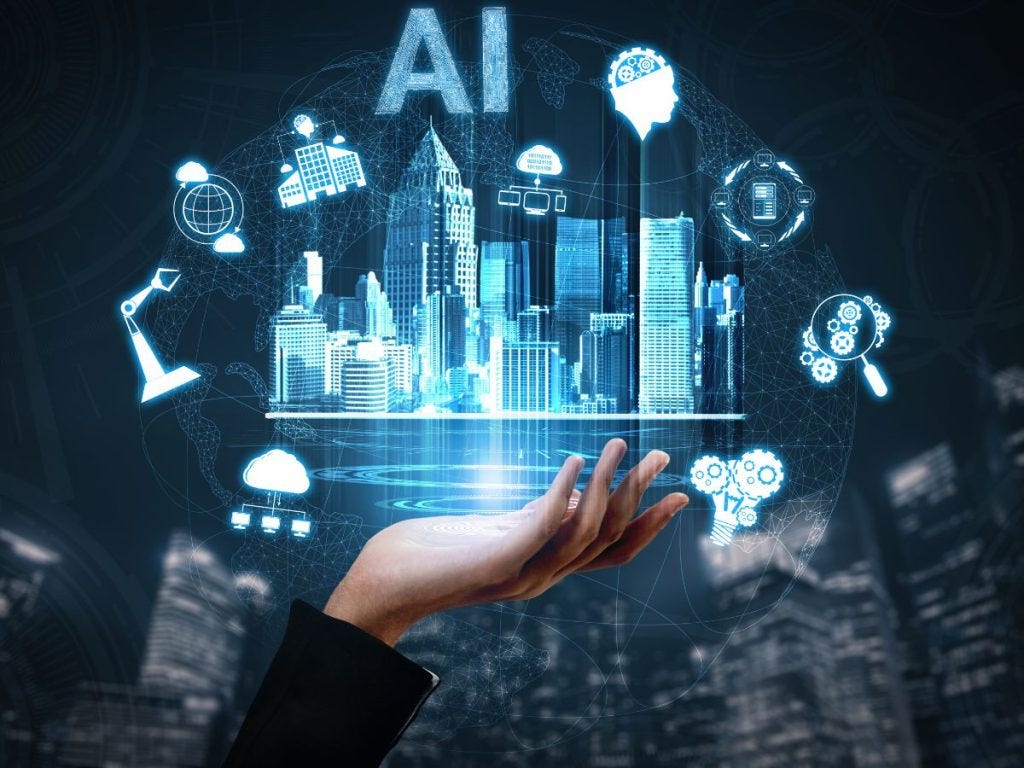AI and the Point of Diminishing Returns
Is throwing everything against the wall the best approach?
After a recent, yet short and minor, dip in the stock market valuations, the AI gold rush continues unabated. In previous essays, I’ve gone on record to state that I think the current way AI is trained is a dead alley, an approach that will never lead to anything like human level intelligence.
Another thing that makes me doubt if the current batch of AI apps will ever reach something approaching human intelligence is the enormous amount of training data. Leaving aside for the moment the legality and ethics of relentlessly downloading all source material on which they can get their (electronic) hands on for training, I can’t help but wonder: if such an artificial intelligence needs all that data and then still is so stupid at many tasks that humans find easy, maybe the whole methodology is faulty?
The current models of Open AI, Google Gemini and Claude are trained on massive amounts of data. Last year, ChatGPT was trained on 570 GB of data (or 300 million words—which is a strange way of measuring, as the official Oxford Dictionary of English only has about one million words. Where do the other 299 million come from?), and DALL-E on 5.8 billion image pairs.
Of course, quantity isn’t everything. The quality of the training data is—I suspect—at least as important. But who is curating the quality of the training data? How many humans does one need to sift through
I have an inkling that the company which starts to really, carefully curate the training data—which will need a lot of human effort—will eventually be ahead in the AI race. Right now, it seems to be easier to just throw more data at the AI wall, but it’s already running into the point of diminishing returns.
For one, according to The Conversation, “Researchers warn we could run out of training data to train AI by 2026.” Wait what? In two years all the available knowledge on the world wide web isn’t sufficient to train an AI in simple things like telling the truth or even determining if certain information is applicable to which person and why?
Even more worryingly, according to the above-mentioned The Conversation article, ‘another option is to use AI to create synthetic data to train systems’. Which gives me even more pause: we need more data to train AI better, but instead of using actual data we use an AI—who, by definition, isn’t trained perfectly—to generate data to feed into another AI? So instead of garbage in—>garbage out we take the circuitous route of garbage in—>generate synthetic garbage—>garbage out? Well, anything to avoid actual intelligent human beings to curate your data, I suppose.
You don’t believe me about the concept of ‘synthetic data’? In the linked Forbes article “Synthetic Data Is About to Transform Artificial Intelligence” the example of self-driving car software is used.
To quote:
“So instead, AV companies developed sophisticated simulation engines to synthetically generate the requisite volume of data and efficiently expose their AI systems to the “long tail” of driving scenarios. These simulated worlds make it possible to automatically produce thousands or millions of permutations of any imaginable driving scenario—e.g., changing the locations of other cars, adding or removing pedestrians, increasing or decreasing vehicle speeds, adjusting the weather, and so on.”
I’m a technician in my day job. I can say with a huge amount of confidence that AIs cannot simulate everything that can happen in the real world. Not even close, otherwise my job—and that of my colleagues—would be in danger. In reality and to the contrary, it’s extremely difficult to find qualified engineers in a huge range of industries and technological applications. My official job title is ‘senior instructor’ and when I train an international group(1) of young and talented people, and I mention that AI-controlled robots will take over their work soon, all of them, every single on of them burst out laughing. And I fully agree.
(1) The last group had people from Scotland, Nigeria, China, Italy and The Netherlands, and you wouldn’t believe how well they worked together near the end of the 9-day training session;
That is, I don’t believe for a minute that the ‘sophisticated simulation engines’ will encompass the most—let alone all—possible driving scenarios. For example before I went to the Glasgow WorldCon, I flew into Glasgow Airport, rented a car and drove to Campbeltown (in order to visit the Springbank distillery). Once outside the Glasgow area, this becomes a narrow two-lane road with traffic in both directions through the very hilly Scottish countryside. On top of that, it started to rain. And not a little bit, as some parts of the road were fully covered in water. You try to avoid these parts, but sometimes you can’t due to traffic from the other direction.
On top of that, there are cars behind you driven by local Scots who know these roads inside out, meaning they constantly try to pass you. On top of that, the Hyundai I rented had an anti-collision system that tried to keep me in the middle of—what it thought was—the road(2), meaning I had to steer against it many, many times. In the torrential rains I didn’t have the time to figure out how to switch it off, so I just overruled it by muscle force. This did demonstrate to me how wrong this ‘self-driving’ feature often was. In several scenarios, it would have killed me (and the people in the oncoming car).
(2) It was distressingly wrong, many times;
So training self-driving cars on synthetic data? Please count me out or give me the option to switch it off(3). I won’t trust my life with it. No way.
(3) And really switch it off, not the illusion of having it switched off;
Therefore, I think training AIs with synthetic data when that AI is used in life-and-death scenarios like driving a car, is madness. And no matter how much synthetic data is used, real life tests remain essential, as reality can never be fully simulated(4). The moment Airbus or Boeing are going to test their new airplanes on synthetic data alone is the moment I will avoid these planes like the plague, or even stop flying. Only real life tests will unearth the problems with new designs.
(4) Even if the simulation hypothesis philosophers think otherwise. But I will publish my essay proving that we are not living in a simulation after my short story “David Bowie Eyes” is published;
So what should AI designers do? I’ve already given one simple answer: use human curation for the training data(5). But isn’t that expensive? Well, I’d say, it depends. According to this Fortune article “AI Training Dataset Market”, the global AI training dataset market is projected to grow from $2.92 billion in 2024 (this year) to $17.04 billion by 2032. That’s a lot of money, for which you can hire—assuming a $200,000 yearly salary—14,600 people (of the 2024 number) to 85,200 people (for the 2032 number).
(5) It’s already happening, but a lot of human interference with AI happens after things go wrong. I suspect trying to filter out problems before they happen will be—in the long term—more cost-effective;
So which company is going to be the first to hire, say, a thousand qualified humans to curate the datasets for their AI? At the previously mentioned $200,000 yearly salary that would be a $200 million investment, which is basically pocket change for companies like Alphabet (Google owners), Microsoft or Apple.
As anybody who has read my previous essays about AI knows, I believe AI can only have a human-like intelligence if it is trained like a human; that is, educated by interaction with peers and has the required evolutionary programming. This will be a long and arduous road, but the only one that has proven itself. Now the AI-powers-that-be throw terabytes of data against the wall with ever-diminishing returns. How long will they throw good money after bad? This is showing all the signs of the next stock market bubble.
But this road will only lead to diminishing returns with the end goal—100% correct responses—always remaining out of sight. Right now, the accuracy of current AI at certain tasks approaches 90%, which sounds impressive. And this might be sufficient for tasks like writing advertisement texts, convincing(6) CV’s, promo copy, or even school essays.
(6) Which are so convincing that recruiters have stopped requesting them. Think about it: if every single applicant can produce a highly convincing résumé by using online AI apps, then this does not filter out anybody, so recruiters need to look for other ways to determine if an applicant is suitable for the job(7);
(7) Like the time-consuming job interview, which—many recruiters hoped—might have been replaced by using an AI hiring tool. The converse—human interaction is not just better, but preferred—is increasingly becoming clear;
However, for essential—even critical—tasks, 90% (or 95% or even 99%) is not enough. A one-in-a-hundred chance that self-driving software makes a mistake is not a chance I am willing to take. Even if you commute to work only two days a week, then the chances of a dangerous accident are once every year. Similarly if one uses AI for coding. Even if the AI app gets 99% right, then the chances of this software crashing are still one-in-a-hundred, meaning several times per year (or more frequent if you use that software more intensely or more often). And do you want the co-pilots on your commercial flight be replaced by AI? If your human captain has an accident, then there’s a one-in-hundred chance that the AI pilot crashes the airplane.
So I’m going out on a limb here and say that the current way AI is being developed means AI is not and will not be ready for prime time. Not now, not next year, not next decade or century, but never. Unless the approach to developing AI changes qualitatively. In the meantime I strongly recommend to treat AI as a tool, not as the purveyor of truth or the embodiment of perfection, neither of which it will ever be.
Author’s note: hey, an essay! Gradually, we’re returning to normal service. If all goes well, there will be plenty of new material, as well. Fingers crossed, stay tuned and many thanks for reading!








Sorry for the late reply, Maura. The AI hype may have run its course.
It's getting interesting, as current AI models like ChatGPT are not generating enough money: https://www.techspot.com/news/103981-openai-massive-running-costs-could-push-close-bankruptcy.html .
Terrific analysis, Jetse. Those hyping AI the most probably have a team of people running their lives and won't be firing them anytime soon!